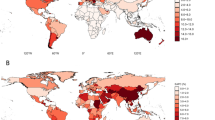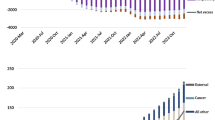Abstract
Objective: To describe regional trends in premature mortality in Manitoba
Design: Comparison of all-cause and causespecific mortality of persons less than age 75 in 11 Regional Health Authority populations over two time periods: 1985–89 and 1990–94.
Results: The provincial premature mortality rate declined over the two time periods (4.00/1,000 to 3.72/1,000). Declines were also observed in 9 of 11 regional populations. Premature mortality increased, however, in the 2 regional populations with the highest mortality rates in the first observation period.
Conclusion: Declining premature mortality in low mortality populations and rising premature mortality in high mortality populations has resulted in a widening of regional mortality rates in Manitoba. Recent policy initiatives in many provinces, including the devolution of authority for the management and delivery of health services and the implementation of population need-based funding formulas to share health care resources among regional health authorities, if implemented, have the potential to partially mitigate the processes producing these widening regional health inequalities.
Résumé
Objectif: décrire les tendances régionales de la mortalité prématurée au Manitoba.
Conception: comparaison de toutes les causes et des causes spécifiques de mortalité chez les personnes de moins de 75 ans dans onze populations d’autorités sanitaires régionales au cours de deux périodes, soit de 1985 à 1989 et de 1990 à 1994.
Résultats: le taux de mortalité prématurée provincial a baissé au cours des deux périodes (de 4 pour 1 000 à 3,72 pour 1 000). Des baisses ont également été observées chez neuf des onze populations régionales. La mortalité prématurée a toutefois augmenté chez les deux populations régionales qui avaient les plus hauts taux de mortalité au cours de la première période d’observation.
Conclusion: la baisse de la mortalité prématurée chez les populations présentant un faible taux et la hausse de la mortalité prématurée chez les populations présentant un taux élevé ont eu pour effet d’augmenter les taux de mortalité au Manitoba. De récentes initiatives de politique dans de nombreuses provinces — y compris le transfert du pouvoir pour la gestion et la prestation des services de santé, ainsi que la mise en place de formules de financement basées sur les besoins de la population pour partager les ressources de soins de santé entre les autorités sanitaires régionales — si elles sont mises en application — ont le potentiel de limiter les processus qui produisent ces inégalités croissantes dans la santé au niveau régional.
Similar content being viewed by others
References
Wilkins R, Adams O, Brancker A. Changes in mortality by income in urban Canada from 1971 to 1986*. Health Rep 1991;1(2):137–74.
Nagnur D. Longevity and historical life tables 1921–1981 (abridged), Canada and provinces. Statistics Canada, catalogue 89–506. Ottawa: Minister of Supply and Services Canada, 1986.
Carriere KC, Roos LL. Comparing standardized rates of events. Am J Epidemiol 1994;140:472–82.
Personal communication, NP Roos, May 1999. Unpublished data.
Carstairs V, Morris R. Deprivation, mortality and resource allocation. Community Medicine 1989;11:364–72.
Townsend P, Davidson N. Inequalities in Health: The Black Report. London: Penguin, 1982.
Pappas G, Queen S, Hadden W, Fisher G. The increasing disparity in mortality between socioe-conomic groups in the United States, 1960 and 1986. N Engl J Med 1993;329:103–9.
Phillimore P, Beattie A, Townsend P. Widening inequality of health in northern England, 1981–91. Br Med J 1994;308:1125–28.
Feldman JJ, Makuc DM, Kleinman JC, Cornoni-Huntley J. National trends in educational differentials in mortality. Am J Epidemiol 1989;129(5):919–33.
Wilkinson RG. Class mortality differentials, income distribution and trends in poverty 1921–1981. J Soc Pol 1989;18:307–35.
Independent inquiry into inequalities in health. London: Stationary Office, 1998.
Raleigh VS, Kiri VA. Life expectancy in England: Variations and trends by gender, health authority and level of deprivation. J Epidemiol Commun Health 1997;51:649–58.
Fogel RW. The conquest of high mortality and hunger in Europe and America: Timing and mechanisms. In: Lander D, Higgonet C, Rosovsky H (Eds.), Favorite of Fortunes: Technology, Growth and Economic Development Since the Industrial Revolution. Cambridge: Harvard University Press, 1991;33–71.
Wilkinson RG. Unhealthy Societies: The Afflictions of Inequality. New York: Routledge, 1996.
Mustard CA, Frohlich N. Socio-economic status and the health of the population. Medical Care 1995;33:DS43–54.
Shanahan M. Provincial expenditures on health care to Manitobans. Unpublished report. Winnipeg: Manitoba Centre for Health Policy and Evaluation, June 1997.
Birch S, Abelson J. Is reasonable access what we want? Implications of, and challenges to, current Canadian policy on equity in health care. Int J Health Services 1993;23:629–53.
Birch S, Chambers S. To each according to needs: A community-based approach to allocating health care resources. Can Med Assoc J 1993;149:607–12.
Health and Welfare Canada. Achieving Health for All: A Framework for Health Promotion. Ottawa: Ministry of Supply and Services, 1988.
Strategic Programs Branch. Introduction of Needs-Based Allocation of Resources to Saskatchewan District Health Boards for 1993–94. Saskatchewan Health, 1994.
Report of the Resource Allocation Working Group, Community Health Framework Project. Toronto: Ontario Ministry of Health, February 1995.
Ministry of Health and Social Services. Health and Well-Being: The Quebec Perspective. Quebec: Government of Quebec, 1993;45.
British Columbia Ministry of Health and Ministry Responsible for Seniors. Regional Funding Methodology. A Resource Allocation Initiative to Support the Regionalization of Health Care Services. Victoria, British Columbia, February 1996.
Mustard CA, Derksen S. A Needs-based Funding Methodology for Regional Health Associations. Manitoba Centre for Health Policy and Evaluation. Report 97.01, Winnipeg, Manitoba. January 1997.
Birch S, Eyles J, Newbold KB. Paper No. 95-10 The Inevitability of Mortality? Evaluating Alternatives to the SMR. Anonymous CHEPA: McMaster University, 1995.
Birch S, Eyles J, Hurley J, et al. A needs-based approach to resource allocation in health care. Can Public Pol 1993;19:68–85.
Eyles J, Birch S. A population needs-based approach to health care resource allocation and planning in Ontario: A link between policy goals and practice? Can J Public Health 1993;84:112–17.
Palmer S, West P, Patrick D, Glynn M. Mortality indices in resource allocation. Community Medicine 1979;1:275–81.
Forster D. Mortality, morbidity and resource allocation. Lancet 1977;1:997–98.
Pampalon R. Avoidable mortality in Quebec and its regions. Soc Sci Med 1993;37:823–31.
Lévesque B, Rochette L, Gingras S. Mortalité attribuable au tabagisme au Québec. Can J Public Health 1998;89:28–32.
British Columbia Provincial Health Officer. A Report On the Health of British Columbians: Provincial Health Officer’s Annual Report 1994. Victoria, British Columbia.
Pampalon R, Saucier A, Berthiaume N, et al. Des indicateurs de besoins pour l’allocation interrégionale des ressources. Direction générale de la planification et de l’évaluation. Ministère de la Santé et des Services sociaux. Gouvernement du Québec. Février 1995.
Author information
Authors and Affiliations
Corresponding author
Additional information
This research was supported in part by funding from the Canadian Health Services Research Foundation and the Manitoba Centre for Health Policy and Evaluation
Rights and permissions
About this article
Cite this article
Mustard, C.A., Derksen, S. & Black, C. Widening Regional Inequality in Premature Mortality Rates in Manitoba. Can J Public Health 90, 372–376 (1999). https://doi.org/10.1007/BF03404137
Received:
Accepted:
Published:
Issue Date:
DOI: https://doi.org/10.1007/BF03404137




